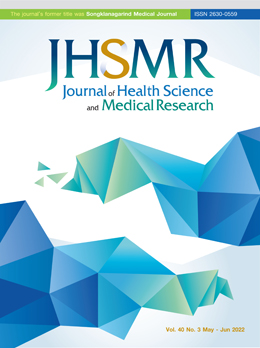The Impact of Chronic Neck Pain on Respiratory Functions among Female University Students
DOI:
https://doi.org/10.31584/jhsmr.2021843Keywords:
chronic neck pain, respiratory functions, SpirometerAbstract
Objective: Students with chronic neck pain have several issues that could constitute susceptibility to respiratory dysfunction. So, this current study was conducted to investigate the impact of chronic neck pain on respiratory function among female university students.
Material and Methods: In this cross-sectional study, 60, female University students voluntarily participated, and were divided into two groups: 30 students with chronic idiopathic neck pain (age=21.9 2.2 years, height=160.7 6.5 cm, weight=71.9 8.5 kg, body mass index (BMI)=28 3.6 kg/cm2), and 30 healthy students as the control group (age=21.5 2.1 years, height=163.5 6.8 cm, weight=69.5 11 kg, BMI=26.2 5 kg/cm2). Both groups were investigated using a Spirometer (One-FlowTM Forced Vital Capacity (FVC) Kit, USA, Granbury). Descriptive statistics and Multivariate analysis of the variance test were both used to compare both groups.
Results: Students with chronic neck pain were found to have statistically significant reductions in Peak Expiratory Flow and the Forced Expiratory Volume in one second (FEV1)/FVC ratio (p-values=0.043 and 0.000, respectively). However, FVC (p-value=0.372) and FEV1 (p-value=0.840) revealed no statistically significant differences between both groups.
Conclusion: Respiratory dysfunction, with chronic neck pain mainly manifests as respiratory weakness and hypocapnia. Studying the hypothesis of neck pain, and its possibility of causing respiratory dysfunction in these subjects gives rise to important clinical implications concerning the assessment and treatment of patients with chronic neck pain.
References
Cresswell C, Galantino ML, Myezwa H. The prevalence of fear avoidance and pain catastrophising amongst patients with chronic neck pain. S Afr J Physiother 2020;76:1-9
Cote P, Cassidy JD, Carroll L. The epidemiology of neck pain: what we have learned from our population-based studies. J Can Chiropr Assoc 2008;47:284-90.
Mahmoud NF, Hassan KA, Abdelmajeed SF, Moustafa IM, Silva AG. The relationship between forward head posture and neck pain: a systematic review and meta-analysis. Curr Rev Musculoskelet Med 2019;12:562–77.
Chung S, Jeong Y. Effects of the craniocervical flexion and isometric neck exercise compared in patients with chronic neck pain: a randomized controlled trial. Physiother Theory Pract 2018;34:916-25.
Kapreli E, Vourazanis E, Strimpakos N. Neck pain causes respiratory dysfunction. Med Hypotheses 2008;70:1009-13.
Hossein KA, Leila G, Massoud AA. The association between neck pain and pulmonary function. Am J Phys Med Rehabil 2017;96:203-10.
Dimitriadis Z, Kapreli E, Strimpakos N, Oldham J. Respiratory weakness in patients withCNP. Man Ther 2013;18:248-53.
Do JG, Park CH, Lee YT, Yoon KJ. Association between underweight and pulmonary function in 282,135 healthy adults: a cross-sectional study in Korean population. Sci Rep 2019;9: 1-10.
Gaur P, Saini S, Ray K, Akunov A, Maripov A, Sharma SK. Influence of altitude on pulmonary function: a comparative study on Indian and Kyrgyz healthy males. Def Life Sci J 2020; 5:3-9.
Dimitriadis Z, Kapreli E, Strimpakos N, Oldham J. Pulmonary function of patients with CNP: a spirometry study. Respir Care 2014;59:543-49.
Graham BL, Steenbruggen I, Miller MR, Barjaktarevic IZ, Cooper BG, Hall GL. Standardization of spirometry 2019 update an official American Thoracic Society and European Respiratory Society Technical Statement. Am J Respir Crit Care Med 2019; 2000:e70-88.
Ruppel GL. Manual of pulmonary function testing. 9th ed. Missouri: Mosby; 2009.
Chen G, Jiang L, Wang L, Zhang W, Castillo C, Fang X. The accuracy of a handheld "disposable pneumotachograph device" in the spirometric diagnosis of airway obstruction in a Chinese population. Int J Chron Obstruct Pulmon Dis 2018;13: 2351-60.
Kjeldgaard P, Lykkegaard J, Spillemose H, Ulrik CS. Multicenter study of the COPD-6 screening device: feasible for early detection of chronic obstructive pulmonary disease in primary care?. Int J Chron Obstruct Pulmon Dis 2017;12: 2323-31.
American Thoracic Society/European Respiratory Society. ATS/ ERS statement on respiratory muscle testing. Am J Respir Crit Care Med 2002;166:518-624.
Jung SI, Lee NK, Kang KW, Kim K, Lee DY. The effect of smartphone usage time on posture and respiratory function. J Phys Ther Sci 2016;28:186-9.
Zammit C, Liddicoat H, Moonsie I, Makker H. Obesity and respiratory diseases. Int J Gen Med 2010;3:335-43.
Siafakas NM, Vermeire P, Pride NB, Paoletti P, Gibson J, Howard P, et al. Optimal assessment and management of chronic obstructive pulmonary disease (COPD). The European Respiratory Society Task Force. Eur Respir J 1995;8:1398-420.
Reid WD, Chung F. Clinical management notes and case histories in cardiopulmonary physical therapy. New Jersey: Slack Incorporated; 2004.
Kapreli E, Vourazanis E, Billis E, Oldham JA, Strimpakos N. Respiratory dysfunction in CNP patients. A pilot study. Cephalalgia 2009;29:701–10.
Vandevoorde J, Verbanck S, Schuermans D, Kartounian J, Vincken W. Obstructive and restrictive spirometric patterns: fixed cut-offs for FEV1/FEV6 and FEV6. Eur Respir J 2006; 27:378–83.
Pearce L. How to interpret spirometry results. Nurs Times 2011;107:18–20.
Menzes KKP, Nascimento LR, Avelino PR, Polese JC and Salmela LFT. A review on respiratory muscle training devices. J Pulm Respir Med 2018;8:1-7.
da Fons ca JDM, Resqueti VR, Ben cio K, Fregonezi G, Aliverti A. Acute effects of inspiratory loads and interfaces on breathing pattern and activity of respiratory muscles in healthy subjects. Respir Physiol 2019;10:1-11.
Downloads
Published
How to Cite
Issue
Section
License

This work is licensed under a Creative Commons Attribution-NonCommercial-NoDerivatives 4.0 International License.
























